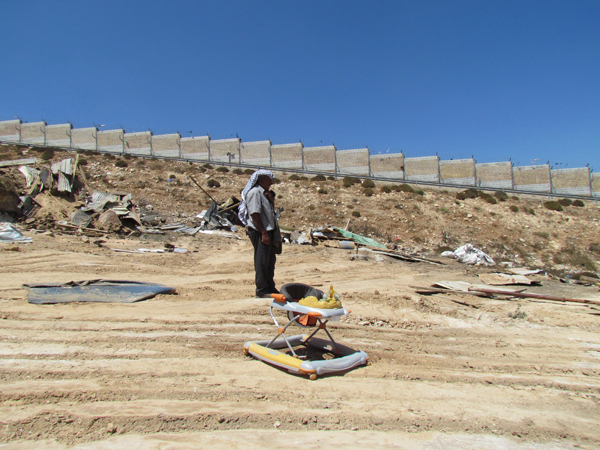
Thousands of Palestinians throughout the occupied Palestinian territory (OPT) have been forcibly displaced or are at acute risk of forced displacement as a result of multiple factors, including policies and practices related to the ongoing military occupation and recurrent hostilities between Israel and Palestinian armed groups. Many Palestinians have suffered multiple displacements, having lost their homes and livelihoods more than once. Forced displacement has a series of immediate and longer-term physical, socio-economic and psycho-social impacts on Palestinian families. It deprives them of their home and land – often their main asset – and frequently results in disruption to livelihoods, a reduced standard of living and limited access to basic services. The impact on children can be particularly devastating.
In the West Bank, including East Jerusalem, displacement is primarily driven by a number of occupation-related policies, including those linked to settlement activity. In Area C and East Jerusalem, each year hundreds of Palestinian homes and other structures are demolished due to the lack of Israeli-issued building permits. The restrictive planning system makes it almost impossible for Palestinians to obtain permits, while providing preferential treatment for Israeli settlements.
Most Palestinians are forced to build without a permit to meet their needs. In many cases, displacement is due to cumulative pressure created by a combination of factors, including settler violence, movement restrictions (including the Barrier) and restricted access to services and resources. East Jerusalemites are also at risk of displacement due to forced evictions, takeover of their property by settler organizations, and the lack of secure residency status. Numerous communities have been temporarily displaced in recent years due to Israeli military training as well.
In the Gaza Strip, displacement has primarily resulted from damage or destruction to homes during hostilities or Israeli military operations. Many people affected during such violence often remain displaced, unable to rebuild or repair their homes due to the long-standing restrictions on import of construction materials and the dire economic situation. In recent years, there has also been some displacement as a result of the Gaza authorities eviction of Palestinian families who were living on "state land".
Key Trends in 2013
- There has been a significant rise in demolitions and displacement in East Jerusalem in 2013; more people have been displaced so far in 2013 than in 2011 (88) and 2012 (73) combined.
- While the monthly average of structures demolished in Area C has increased slightly, up 8 per cent from 2012, the average number of persons displaced is relatively the same, 68 compared to 67.
- There has been a 127 per cent increase in the number of demolitions in the Jordan Valley in 2013 when compared to 2012 (from 172 demolished structures to 390); Bedouin and herding communities have been worst affected.
- Some 12,500 people in the Gaza Strip remain displaced, following destruction of their homes during previous Israeli military operations.
| People displaced due to demolitions or evictions |
Total in 2013 |
2014 | |||||||||||
| Jan. | Feb. | March | April | May | June | July | Aug. | Sep. | Oct. | Nov | Dec | ||
| Of which were displaced in Area C | 805 | 160 | 24 | 17 | 171 | 156 | 42 | 0 | 98 | ||||
| Of which were displaced in East Jerusalem | 298 | 23 | 34 | 28 | 8 | 8 | 0 | 0 | 20 | ||||
| Grand Total | 1103 | 183 | 58 | 45 | 179 | 164 | 42 | 0 | 118 | ||||
| Demolitions of structures | Total in 2013 | 2014 | |||||||||||
| Jan. | Feb. | March | April | May | June | July | Aug. | Sep. | Oct. | Nov | Dec | ||
| Of which in Area C | 565 | 101 | 17 | 5 | 87 | 70 | 30 | 6 | 24 | ||||
| Of which in East Jerusalem | 98 | 7 | 9 | 9 | 4 | 4 | 6 | 2 | 5 | ||||
| Grand Total | 663 | 108 | 26 | 14 | 91 | 74 | 36 | 8 | 29 | |
|||
Monthly figures: People displaced due to demolitions or evictions
OCHA OPT Resources
Fact Sheet: Communities in the Jerusalem periphery at risk of forced displacement | June 2013
Fact Sheet: The Humanitarian Impact of Israeli-declared "Firing Zones" in the West Bank | August 2012
Fact Sheet: Demolitions and forced displacement in the occupied West Bank | January 2012
Special Focus: Displacement and Insecurity in Area C of the West Bank | August 2011
Special Focus: East Jerusalem -- Key Humanitarian Concerns I March 2011
Fact Sheet: East Jerusalem - Key Humanitarian Concerns | December 2011
Case Study: Dislocated Communities: The Case of Khirbet Khamis | November 2013
Case Study: Dislocated Communities: The Bir Nabala / Tel alAdassa Case Study | September 2013
Case Study: Life in a "Firing Zone": The Massafer Yatta Case Study | May 2013
Annual Review: Fragmented Lives - Humanitarian Overview 2012
Annual Review: Fragmented Lives - Humanitarian Overview 2011
Useful Links
United Nations Office for the Coordination of Humanitarian Affairs Thematic Page on Displacement
Special Rapporteur on the Human Rights of Internally Displaced Persons
United Nations High Commissioner for Human Rights
United Nations Relief and Works Agency for Palestine Refugees in the Near East (UNRWA)
International Displacement Monitoring Centre









